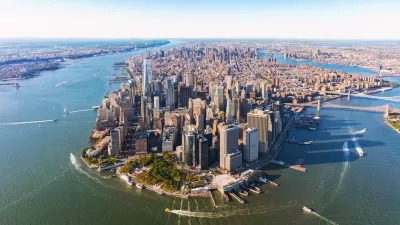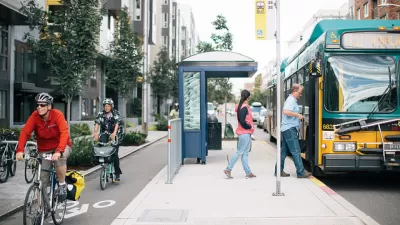As cities build upwards in an effort to create more housing and increase walkability, research shows that tall buildings intensify heat and contribute to increased carbon emissions.

"A report by the United Nations’ Intergovernmental Panel on Climate Change released on Monday looked at the relationship between housing, building structures, and broiling city blocks and found that deaths from heatwaves — like the one in Chicago [in 1995] — are not a coincidence," reports Adam Mahoney. The "report found that the single biggest contributor to amplifying heat and warming in cities is 'urban geometry,' the relationship between city layouts, building construction, and density," and that "[t]he main problem driving the so-called 'heat-island effect' is tall buildings." Because of this, "[u]rban centers can range as much as 22 degrees warmer than nearby rural areas."
[C]ities and states across the country — in Ohio, New York City, and back in Chicago, developers are building taller affordable housing, going up, not out, in an effort to create density, walkable neighborhoods where infrastructure costs are lower and jobs, stores, and homes are closer together. The trick is finding a solution that offers everyone safe and quality housing without overheating the planet.
John Mandyck, CEO of the Urban Green Council in New York City, says "[c]ities could create gardens in the sky, which have successfully offered natural cooling and improved air quality in cities like Chicago, as well as planting trees and bushes to shade sidewalks and streets." Other solutions include reflective roofing systems, which in New York City alone prevent "an estimated 2,500 tons of CO2 emissions every year."
While building up may mitigate the housing crisis, "it’s not even one percent of the solution to our environmental problems because it adds challenges even as it mitigates some," says Rick Cole, executive director of the Congress for New Urbanism. "More than 25 years after that first Cabrini tower came down, U.S. cities are much more equipped to tackle housing problems and the climate crisis, but action requires political willpower and individual sacrifices."
FULL STORY: Tall buildings: Good for the housing crisis, bad for the climate crisis

Alabama: Trump Terminates Settlements for Black Communities Harmed By Raw Sewage
Trump deemed the landmark civil rights agreement “illegal DEI and environmental justice policy.”

Planetizen Federal Action Tracker
A weekly monitor of how Trump’s orders and actions are impacting planners and planning in America.

The 120 Year Old Tiny Home Villages That Sheltered San Francisco’s Earthquake Refugees
More than a century ago, San Francisco mobilized to house thousands of residents displaced by the 1906 earthquake. Could their strategy offer a model for the present?

Opinion: California’s SB 79 Would Improve Housing Affordability and Transit Access
A proposed bill would legalize transit-oriented development statewide.

Record Temperatures Prompt Push for Environmental Justice Bills
Nevada legislators are proposing laws that would mandate heat mitigation measures to protect residents from the impacts of extreme heat.

Downtown Pittsburgh Set to Gain 1,300 New Housing Units
Pittsburgh’s office buildings, many of which date back to the early 20th century, are prime candidates for conversion to housing.
Urban Design for Planners 1: Software Tools
This six-course series explores essential urban design concepts using open source software and equips planners with the tools they need to participate fully in the urban design process.
Planning for Universal Design
Learn the tools for implementing Universal Design in planning regulations.
Clanton & Associates, Inc.
Jessamine County Fiscal Court
Institute for Housing and Urban Development Studies (IHS)
City of Grandview
Harvard GSD Executive Education
Toledo-Lucas County Plan Commissions
Salt Lake City
NYU Wagner Graduate School of Public Service





























